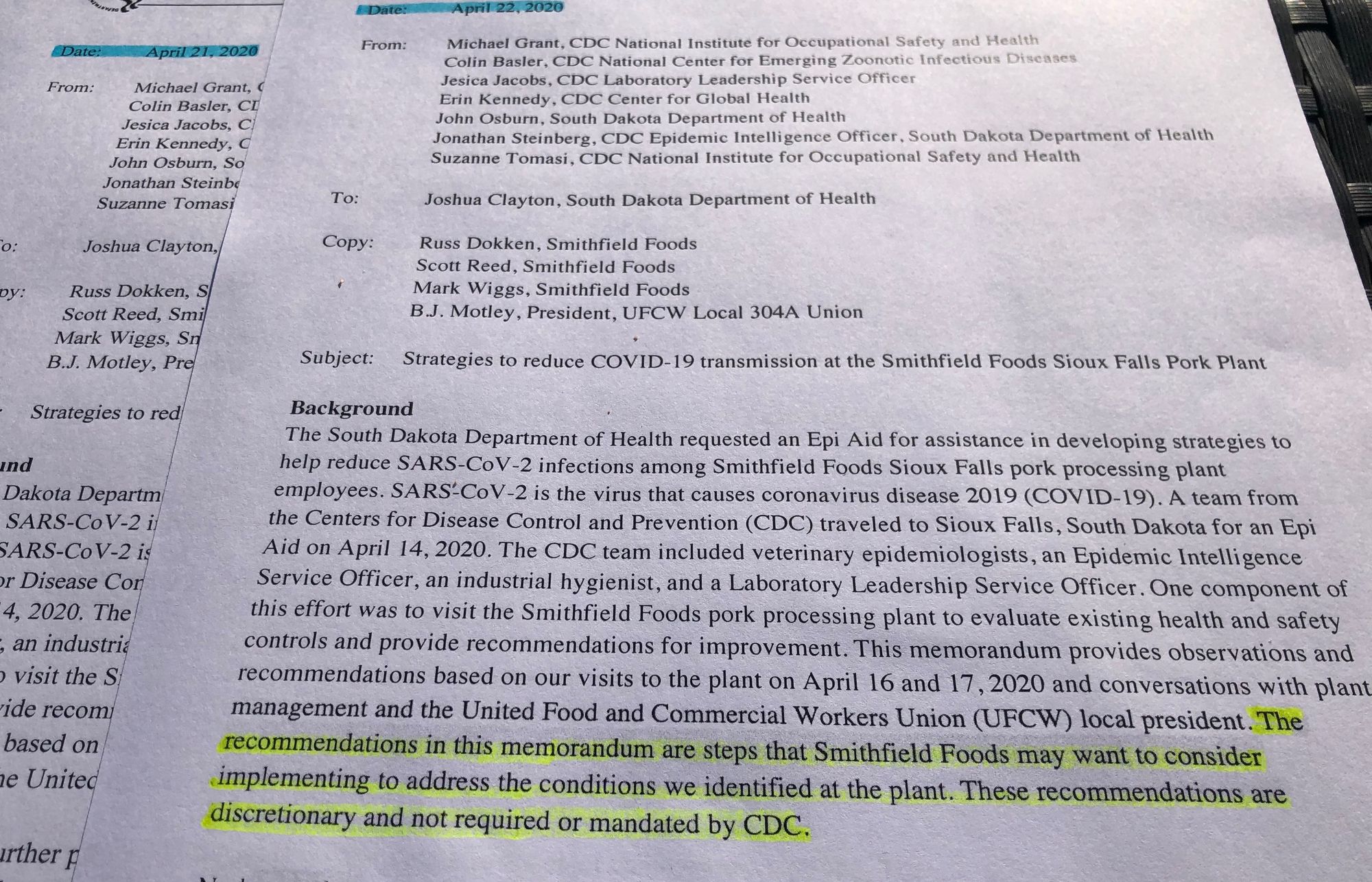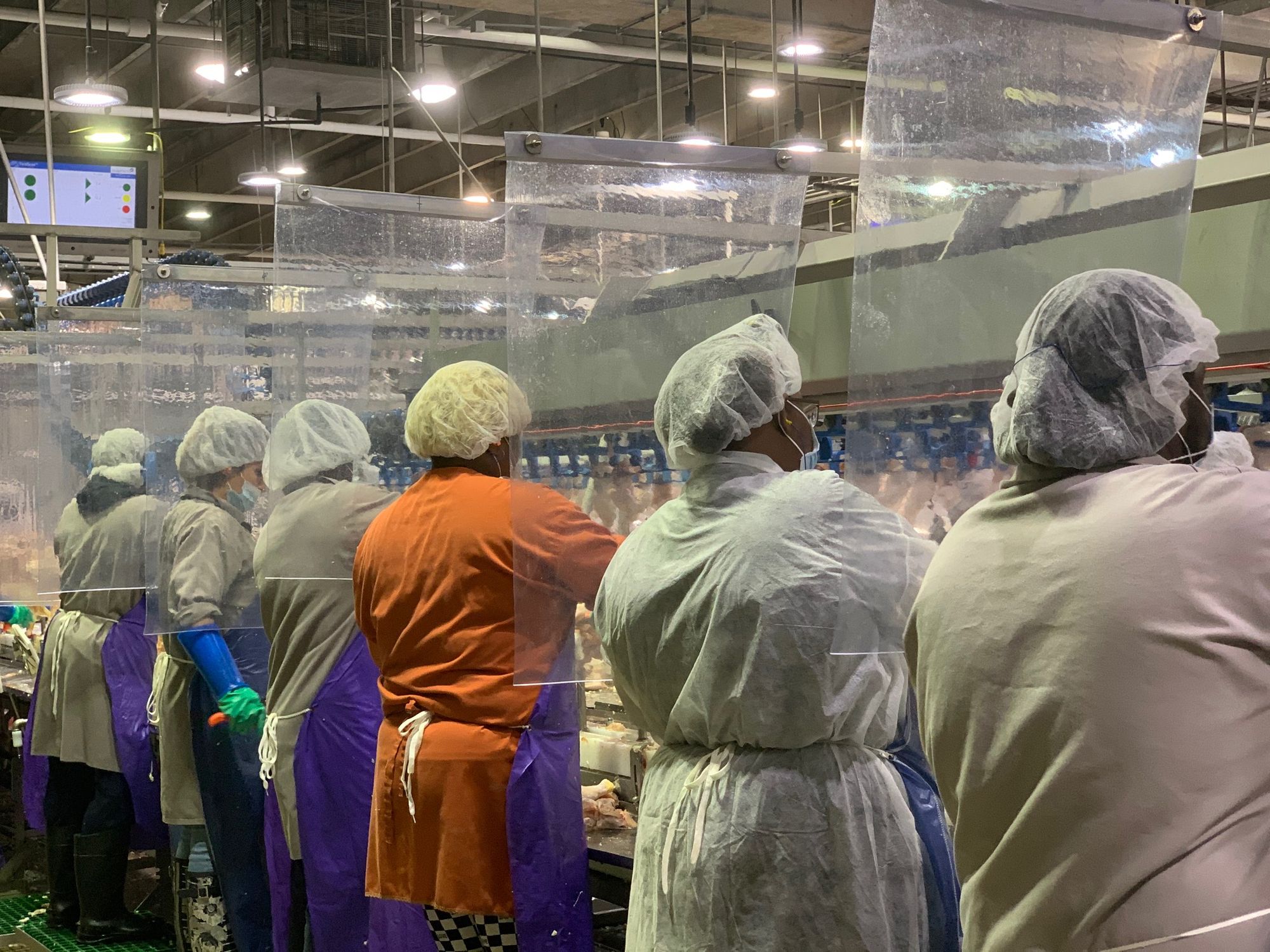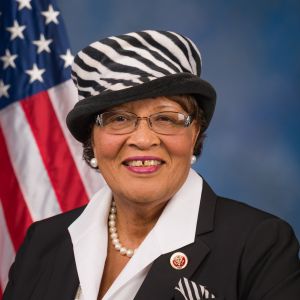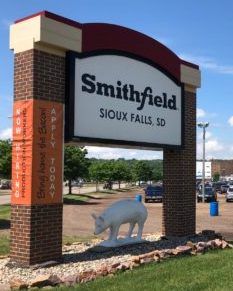The federal Centers for Disease Control and Prevention approved a final report on a massive COVID-19 outbreak at the Smithfield Foods plant in Sioux Falls, then retracted that report and redid a second final report with much less stringent worker-safety recommendations.
The first report was dated April 21, 2020, and included 15 pages of recommendations for improved safety. The second report, issued the next day, included many of the same recommendations but with added language stating that safety improvements were “discretionary and not required” to be implemented by Smithfield.
The second report also contains numerous references to safety measures that should be implemented only “if feasible” or “if possible,” including whether sick employees should stay home, whether dirty or wet masks should be replaced, and whether protective barriers should be used to keep workers safe.
The Smithfield pork processing plant in downtown Sioux Falls became the largest COVID-19 hotspot in the country in April; in all, about 929 workers and 210 close contacts of workers were known to be sickened, leading to two deaths, according to the state. Smithfield was fined $13,494 by federal regulators in early September.
The CDC sent in a team of inspectors to the Sioux Falls plant in mid-April to complete what is known as an “Epi Aid” investigation into the outbreak and to make safety recommendations. The review was requested by the South Dakota Department of Health.

A congressional inquiry has been launched to find out who is responsible for what Democratic lawmakers said is the “watering down” of the CDC report recommendations, and to discover why and when the changes to the first version of the report were made. A member of the House of Representatives who chairs a subcommittee on worker safety raised concerns on Sept. 30 that politics may have played a role in the rewriting of the CDC report.
Robert Redfield, head of the CDC, told a U.S. Senate committee in September that the changes were made simply to note that CDC safety recommendations are suggestions and not requirements. However, such notations were not made in past CDC reports, including a report on a COVID-19 breakout at a Colorado meat plant issued just two days before the release of the Smithfield report.
News Watch has confirmed through congressional records that the South Dakota Department of Health was given a “pre-clearance draft” copy of the first version of the report by email on April 20, the day before the initial version was to be released.
Those records also indicate that officials from the Smithfield plant in Sioux Falls were also given a draft copy of the first version of the report before its release.
Officials with the health department, including Secretary Kim Malsam-Rysdon and epidemiologist Joshua Clayton, who is listed as the primary recipient of both CDC reports, did not respond to specific questions sent to them by News Watch.
Instead, health department spokesman Derrick Haskins said in an email to News Watch, “We would refer you to CDC for questions related to its report. Dr. Clayton, Sec. Malsam-Rysdon, and Governor Noem were primarily responsible for requesting the initial CDC and NIOSH support to help assess the COVID-19 mitigation practices at Smithfield Foods and disseminating the investigation findings from the report.”

Changes softened safety recommendations
A News Watch line-by-line review of the two versions of the CDC reports on the Smithfield plant found 24 alterations from the first version to the second version.
The most substantive additions come on the first and fifth pages, with language added to the second version in two places that was not in the first version. Those two added passages both note that, “The recommendations in this memorandum are steps that Smithfield Foods may want to consider implementing to address the conditions we identified at the plant. These recommendations are discretionary and not required or mandated by the CDC.”
In the “Recommendations” section on Page 5, the initial report contains language that was removed from the second report, including that the following actions are recommended “to ensure that existing and future control efforts are effective in preventing the spread of COVID-19.”
Later in that section, language in the first version states that Smithfield officials, the state health department and community partners “should develop an implementation plan for these and other interventions … that should be rolled out in the workplace” to reduce the spread of COVID-19. The wording is changed in the second version to say that those groups should “work together to implement recommendations and plans” to reduce the spread.
In all, the second version of the report includes 14 references to implementing safety measures and procedures “where feasible,” “if feasible” or “if possible.”
The “if possible” or “wherever possible” statements are added in the second version to recommendations related to the following:
- Replacing dirty or wet facial coverings.
- Contactless distribution of face masks.
- Use of face masks to enhance worker protection.
- Asking workers about recent history of fever, cough or shortness of breath.
- Use of signs, in-plant messaging and clear language to educate workers on safety measures.
The “wherever feasible” or “if feasible” language was added to the second version of the report in relation to recommendations that:
- The plant eliminate transmission hazards.
- Physical barriers should be used in combination with social-distancing efforts.
- All employees should wear face coverings over their noses and mouths in all areas of the plant.
- Face shields should be used in addition to eye protection
- Hand-sanitizing stations should be located wherever employees take anything from a bin.
- New safety guidance should be reviewed and implemented as it becomes available.
The second version of the report also changes the word “slaughtering” of animals in the first version to “harvesting” of animals in the second version.
The first version of the Smithfield report was reviewed and approved for publication by two separate CDC task forces; it was obtained by News Watch through the U.S. House Education and Labor Committee.
Inquiries about the two Smithfield reports have intensified as members of that committee and others have interviewed federal officials about COVID-19 and industry, and have asked follow-up questions about the Smithfield reports.
U.S. Rep. Dusty Johnson, R-S.D., is a member of that committee; a spokesperson for Johnson said on Oct. 1 that he was not aware of the two versions of the CDC report or any language changes being made.

"Given the information we currently have, it appears as if politics played a role – ultimately leading the CDC to weaken critical workplace safety guidance putting workers’ lives at risk." -- U.S. Rep. Alma Adams, D-North Carolina
Congressional Democrats seek answers
U.S. Rep. Alma Adams, D-N.C., chair of the House Subcommittee on Workforce Protections, said in a statement on Sept. 30 that she was unsatisfied with Redfield’s statements as to why the new language appeared in the second version of the Smithfield report, and added that she was concerned that political considerations may have played a role in softening the CDC guidance.
“Dr. Redfield’s explanation … for why the CDC felt it was necessary to weaken the Epi Aid report language does not hold water, nor has the CDC provided Congress with any substantive reason for changing the report,” Adams said. “Given the information we currently have, it appears as if politics played a role – ultimately leading the CDC to weaken critical workplace safety guidance putting workers’ lives at risk. I am committed to finding out exactly who was involved in this decision, and why they did what they did.”
Adams and three other Democrats who serve on labor and worker-safety committees in Congress sent letters on Sept. 28 to top officials at federal agencies involved in the Smithfield plant investigation, demanding answers to who altered the initial CDC report, when and why.
One letter, seeking information about the “watering down” of the CDC report on the Sioux Falls Smithfield plant COVID-19 outbreak, was sent from U.S. Sens. Tammy Baldwin, D-Wis., and Patty Murray, D-Wash., and U.S. Reps. Robert C. Scott, D-Va., and Alma Adams to Redfield of the CDC, Alex Azar of the Department of Health and Human Services and John Howard of the National Institute for Occupational Health and Safety.
The letter seeks information and correspondence related to the CDC investigation, the compiling of the two versions of the report and the involvement of any and all parties in making changes to the reports, including the South Dakota Department of Health and Smithfield Foods.
Those members of Congress also sent a letter that same day asking for similar information from Sonny Perdue, secretary of the Department of Agriculture.
In a press release announcing that the letters were sent, the members of Congress wrote that on Sept. 23, Redfield appeared before a Senate committee and “testified that he had no contact with the Department of Agriculture, the White House or Smithfield about this matter, which seems to contradict CDC officials who have confirmed an April 22 phone call between the CDC director and the USDA secretary.”
Gov. Noem said on April 16 that she had been in close contact with USDA Secretary Perdue and officials from the Smithfield plant as the investigation into the outbreak was ongoing.
Noem told South Dakota media on April 22 that the USDA and CDC had been in contact with one another regarding the Smithfield investigation.
In response to questions about the two versions of the CDC report posed by News Watch on Sept. 30, Ian Fury, a spokesman for Noem, said, “It’s the CDC’s report, and we’ll defer to them on how it was compiled.”
When asked if Noem was consulted on the contents of the report at any time, Fury wrote, “She was heavily involved in getting the CDC to Smithfield for the purpose of providing recommendations so that the plant could reopen safely.”
The initial report findings and recommendations, those made before the softening of the language, were sent by email on April 20, 2020, to the South Dakota Department of Health, executives of the Smithfield plant and a local union official in Sioux Falls, according to questioning by committee members on May 28 with answers provided by John Howard, director of the National Institute for Occupational Safety and Health.
The second, revised version of the Smithfield report was then sent to the South Dakota health department on April 22, Howard said.
“While the substance of CDC’s recommendations did not change between the first and second version, a sentence was added at the beginning to clarify that this was not a regulatory document and throughout there were some working changes (couched in “if phrases”) to reinforce the non-regulatory nature of the report,” Howard testified.

Smithfield says safety measures now in place
The changes to the Smithfield CDC report have become the subject of further discussion and questioning by some members of Congress.
The questions raised by congressional Democrats come amid concerns that the meat-packing industry played a big role in pushing for plants to stay open or to re-open during the pandemic. Several national news organizations have published emails showing that meatpackers and industry groups provided language that formed the basis of an executive order signed by President Donald Trump in late April declaring meat-processing companies to be “critical infrastructure” that needed to remain open during the pandemic, even as thousands of workers became infected.
The House Education and Labor Committee leadership, in a press release issued Sept. 30, noted that such statements, or “weakening phrases,” are not included in any other CDC Epi Aid reports beyond the Smithfield report.
News Watch reviewed a similar Epi Aid report issued by the CDC after an investigation of a COVID-19 outbreak at the JBS USA beef processing plant in Greeley, Colo. That memorandum was issued on April 20, just one day before the release of the initial CDC report on the Smithfield plant in Sioux Falls.
The JBS memorandum, published in a similar format as the Smithfield memorandum, contains no language indicating the report recommendations are “discretionary” or “not required or mandated” or should be implemented only “if feasible” or “if possible.”
For example, the second, softened version of the CDC memo on the Smithfield plant says that “employees who are ill should stay home if feasible,” with the “if feasible” clause added after the revision of the first report.
Meanwhile, the JBS memo issued only two days earlier states that if plant workers have symptoms consistent with COVID-19, “they are told to return home, surrender their plant identification card, follow up with a telehealth provider” and be notified of available pay and benefits.
In the section outlining CDC safety recommendations, the JBS memo states, “The health and safety committee and labor representatives should develop an implementation plan for these and any other interventions.”
The two versions of the CDC report on the Smithfield plant were sent to company officials Russ Dokken, Scott Reed and Mark Wiggs as well as B.J. Motley, president of the local United Food and Commercial Workers Local 304A union in Sioux Falls. News Watch requests for comment to Motley were not answered.
In response to News Watch questions, Keira Lombardo, Smithfield Foods executive vice president for corporate affairs, said the company has cooperated fully with government inspectors and scientists during the pandemic and has spent $500 million on plant safety.
“We implemented a wide range of measures and protocols well in advance of any government guidance,” Lombardo wrote in an email. “To be very clear, we have implemented CDC recommendations and guidance whether those recommendations and guidance are mandatory or not. Our measures have been working – active cases among our U.S. workforce are at a fraction of 1% and have been for a sustained period.”
Haskins, of the health department, said the state provides updates on COVID-19 clusters when there are more than 40 cases in a single setting. The department has not reported on any new clusters at the Smithfield plant, Haskins said on Oct. 2.



